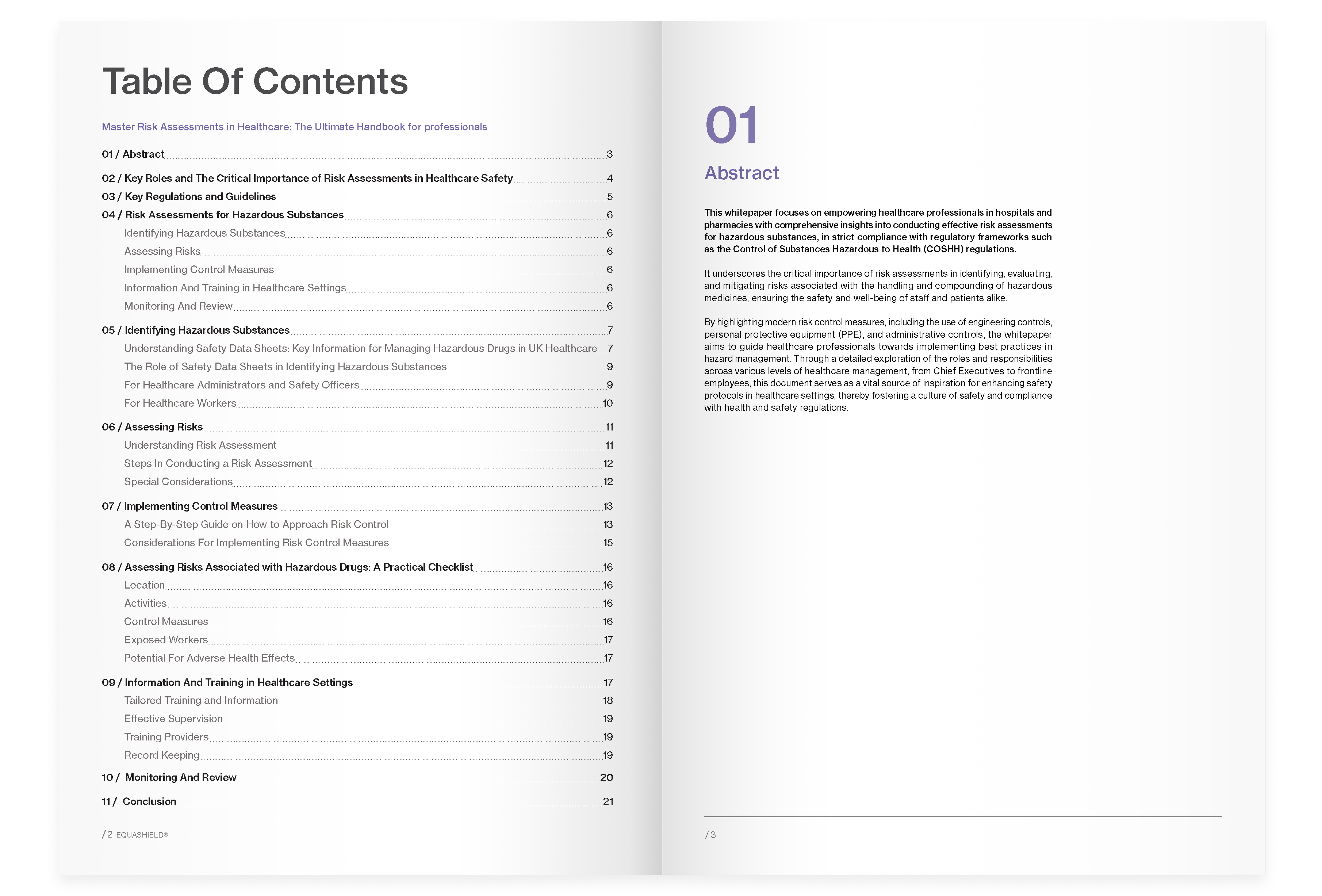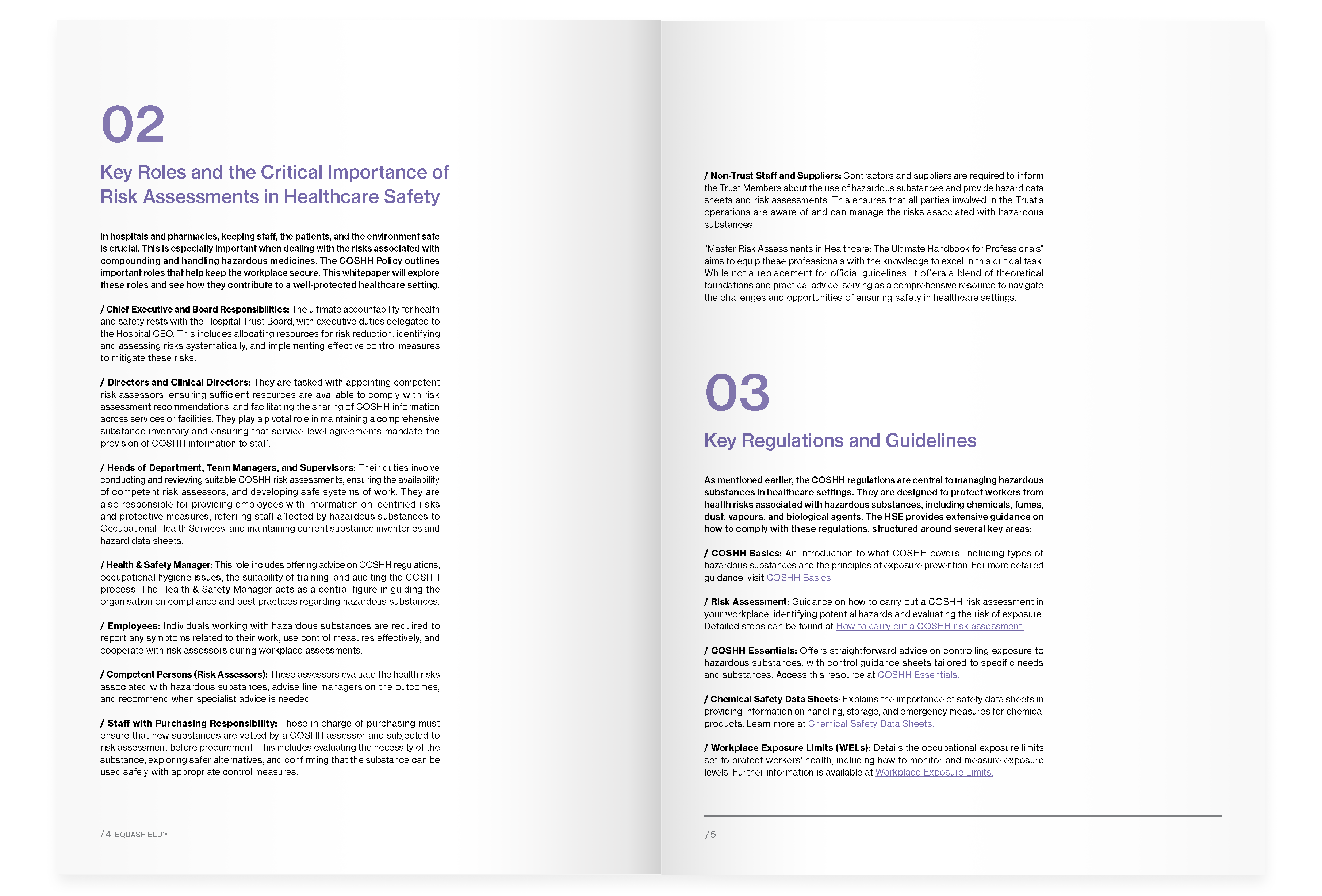
Home / EQ Academy / Resources / Whitepaper: Master Risk
Master Risk Assessments in Healthcare: The Ultimate Handbook for Professionals” is meticulously crafted to guide healthcare professionals through the intricacies of risk assessment for hazardous substances. Secure your copy now and explore comprehensive insights on:



This section provides an in-depth analysis of the pivotal roles healthcare professionals occupy in safeguarding both staff and patients within healthcare settings against health risks posed by hazardous substances. It emphasises the collective responsibility across various levels of healthcare management, from the Chief Executive and Board to frontline employees, in implementing effective risk assessments and proven strategies to ensure occupational safety. The ultimate goal is to foster a culture of security that prioritises the well-being of all individuals in the healthcare environment, highlighting the critical importance of leadership in allocating resources for risk reduction and ensuring compliance with safety standards.
Navigate the complex landscape of COSHH regulations and other essential guidelines that are critical for maintaining high safety standards in healthcare settings. This part of the guide offers a detailed overview of the regulatory framework governing the management of hazardous substances. It provides healthcare professionals with the knowledge needed to navigate compliance issues, ensuring that their facilities adhere to legal requirements and best practices for safety, including the Health and Safety Executive (HSE) guidelines.
Learn the systematic approach to identifying, evaluating, and mitigating risks associated with hazardous substances within your healthcare facility. This section outlines a step-by-step process for conducting thorough COSHH risk assessments, from identifying potential hazards to implementing appropriate control measures. It emphasises the importance of a proactive approach to risk management, ensuring that healthcare environments are safe for both staff and patients and comply with workplace exposure limits.
Gain expertise in recognizing potential hazards in the healthcare environment. This section provides essential information on how to ascertain which medications and substances pose risks, including reviewing product labels and Safety Data Sheets (SDS). It stresses the importance of understanding both the inherent risks of certain drugs and those arising from pharmacy or hospital processes, such as powder from tablet crushing or vapours from medication compounding and the necessity of using personal protective equipment (PPE) and other control measures to adequately control exposure.
Discover strategies for effectively mitigating identified risks to ensure the safety of healthcare environments. This section explores the implementation of control measures following a thorough risk assessment. It covers the selection of safer pharmaceutical alternatives, the use of containment strategies such as specialised ventilation systems and closed-system transfer devices (CSTDs), and the comprehensive use of Personal Protective Equipment (PPE) tailored to specific tasks involved in compounding and administering hazardous medications, aiming to reduce risk and prevent excessive exposure.
Understand the importance of educating healthcare staff on risk assessments and safety protocols. This part emphasises the need for targeted training on the implementation of safety controls, the correct utilization of PPE, and the protocols to follow in emergencies. It highlights how informed and well-trained healthcare professionals are crucial to maintaining a safe working environment and ensuring patient safety, including the use of safety data sheets and respiratory protective equipment as part of the necessary precautions.
Learn about the continuous process of monitoring and reviewing risk assessments to adapt to new challenges and maintain safety standards. This section underscores the importance of regular checks on the effectiveness of control measures and the necessity of reassessing risks as needed. It advocates for annual reviews and updates to risk assessments, ensuring that healthcare facilities can respond effectively to changes in the work environment or the introduction of new hazardous substances, thereby maintaining control over health hazards and ensuring the risk assessment remains valid.
This whitepaper provides a detailed blueprint for establishing a comprehensive framework for conducting risk assessments, which is crucial for safeguarding both patients and healthcare professionals against health risks from hazardous substances. It guides you through the process of systematic hazard identification, risk evaluation, and the implementation of effective control measures, including the use of appropriate protective equipment and strategies to control exposure. This framework is designed to ensure that all aspects of hazardous substance management are addressed, from initial identification to ongoing monitoring, thereby creating a safer healthcare environment that prioritises the well-being of everyone involved.
With the insights provided in this guide, you can navigate healthcare safety regulations with confidence, ensuring your facility’s compliance with current laws and standards, including COSHH regulations and workplace exposure limits. This whitepaper demystifies complex regulations such as COSHH, offering clear, actionable advice on how to meet these requirements straightforwardly. By adhering to the guidelines and strategies outlined, you can enhance your facility’s reputation for safety and compliance, making it a preferred choice for both patients and healthcare professionals.
Adopting a proactive stance in identifying and mitigating risks is essential for creating a safer healthcare environment. This whitepaper empowers you with the knowledge and tools needed to anticipate potential hazards and implement preventive measures before incidents occur. By fostering a culture of proactive risk management, you can significantly reduce the likelihood of adverse events related to hazardous substances, ensuring a safer, more secure environment for patient care. This includes understanding the significance of health hazards, such as occupational asthma and lung or liver disease, and taking the necessary steps to prevent ill health caused by exposure to harmful substances.
One of the key benefits of this whitepaper is its ability to equip your team with the necessary knowledge and skills for the safe handling of hazardous substances. It emphasises the importance of comprehensive training programs and ongoing education to foster a culture of safety and responsibility among all staff members. With this knowledge, healthcare professionals can confidently manage hazardous substances, apply appropriate safety measures, and respond effectively to any incidents, thereby enhancing the overall safety of the healthcare setting. This includes understanding the use of safety data sheets, the importance of respiratory protective equipment, and the need to report defects or significant risks to health.
Committing to continuous monitoring and improvement is vital for maintaining the highest standards of safety and compliance in healthcare facilities. This whitepaper encourages a systematic approach to reviewing and updating risk assessments, control measures, and safety protocols to adapt to new challenges, technologies, and regulations. By embracing a culture of continuous improvement, your healthcare facility can stay at the forefront of safety and compliance, ensuring that it remains a safe and caring environment for patients and staff alike. This involves being vigilant about significant changes, such as the introduction of new cleaning chemicals or the need for specific regulations for handling substances like flour dust and ensuring that the facility provides sufficient information and training to manage these risks effectively.

